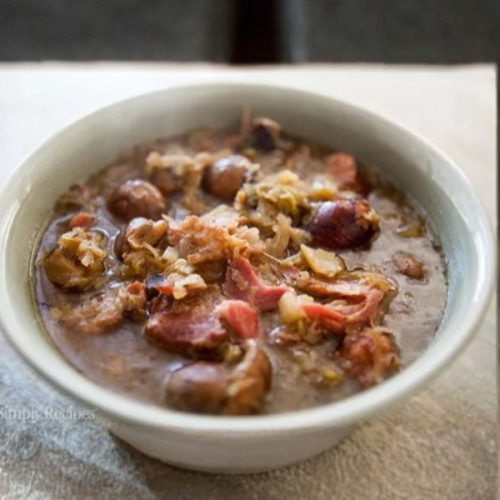
Hearty Slow-Cooked Bigos
A rich Polish Hunter’s Stew combining pork, smoked sausages, cabbage, sauerkraut, and mushrooms, slow-cooked in beer or stock. High in protein and fiber, this hearty, flavor-packed dish improves with time, perfect for large gatherings or meal prep.
Equipment
- 1 Large Heavy-Bottomed Pot
- 1 Chef’s Knife
- 1 cutting board
- 1 Wooden spoon
- 1 Fine-Mesh Sieve
Ingredients
Meats
- 2 pounds pork shoulder cut into large chunks
- 1 –2 pounds kielbasa or smoked sausage cut into chunks
- 1 smoked ham hock
- 1 pound fresh Polish sausage optional
Vegetables & Mushrooms
- 1 25-ounce jar fresh sauerkraut, drained
- 1 green cabbage cored and chopped
- 1 large onion chopped
- 1 1/2 pounds fresh mushrooms cleaned and cut
- 1 ounce dried porcini or wild mushrooms soaked and drained
Flavorings & Spices
- 2 tablespoons bacon fat or vegetable oil
- 1 tablespoon juniper berries optional
- 1 tablespoon black peppercorns
- 1 tablespoon caraway seeds
- 2 tablespoons dried marjoram
Salt to taste
- 2 tablespoons tomato paste optional
- 1 12-ounce bottle pilsner or lager beer
- 1 15-ounce can tomato sauce, optional
- 20 prunes halved, optional
- 1 –2 tablespoons mustard or horseradish optional
Instructions
- Soak and Prep Mushrooms: Pour hot water over the dried porcini or other wild mushrooms and let them soak for 20–40 minutes until softened. Drain and reserve the soaking liquid, then clean off any dirt and cut the mushrooms into large pieces, leaving smaller ones whole.
- Prepare Meats: Cut the pork shoulder into large 2-inch chunks and slice the sausages into similar-sized pieces. Set all meats aside separately to streamline the cooking process and ensure even browning later.
- Brown the Pork Shoulder: In a large heavy-bottomed pot, heat bacon fat or vegetable oil over medium-high heat. Working in batches to avoid overcrowding, brown the pork shoulder evenly on all sides. Remove the meat and set aside, keeping the pan juices to enhance flavor.
- Sauté Onions and Cabbage: Add the chopped onion and green cabbage to the same pot. Sauté for several minutes, stirring frequently, until the cabbage softens and the onions turn translucent. Sprinkle lightly with salt, and use a wooden spoon to scrape up any browned bits from the bottom of the pot.
- Combine Fresh Mushrooms and Cook: Add the fresh mushrooms to the pot without extra oil. Stir often as they release their liquid, sprinkling a little salt to help draw out moisture. Cook until the water nearly evaporates, concentrating their earthy flavor.
- Layer Meats, Sauerkraut, and Seasonings: Return the browned pork shoulder to the pot along with the sautéed cabbage and onions. Add the ham hock, sausages, drained sauerkraut, caraway seeds, marjoram, crushed black peppercorns, and juniper berries if using. Stir to combine all ingredients evenly.
- Add Liquid and Simmer Slowly: Pour in beer or tomato sauce, bringing the stew to a gentle simmer. Cover and cook for at least 2 hours, checking periodically. Once the ham hock is tender, remove it, discard the bones and fat, chop the meat, and return it to the pot. Add the soaked mushrooms, mushroom liquid, and prunes, cooking an additional 30 minutes or until all flavors meld. Serve with mustard or horseradish if desired.
Notes
- Soak dried mushrooms thoroughly to unlock maximum flavor; reserve the soaking liquid to add depth to the stew.
- Browning pork shoulder in batches ensures even caramelization without steaming the meat.
- Bigos is intentionally “dry,” so avoid adding too much liquid; the ingredients will release moisture as they cook.
- Add prunes toward the end to maintain their shape and impart natural sweetness without becoming mushy.
- Mustard or horseradish should be added just before serving for a bright, tangy kick.
- Bigos improves with time; refrigerating or freezing for a day or two intensifies flavors, making leftovers even better.